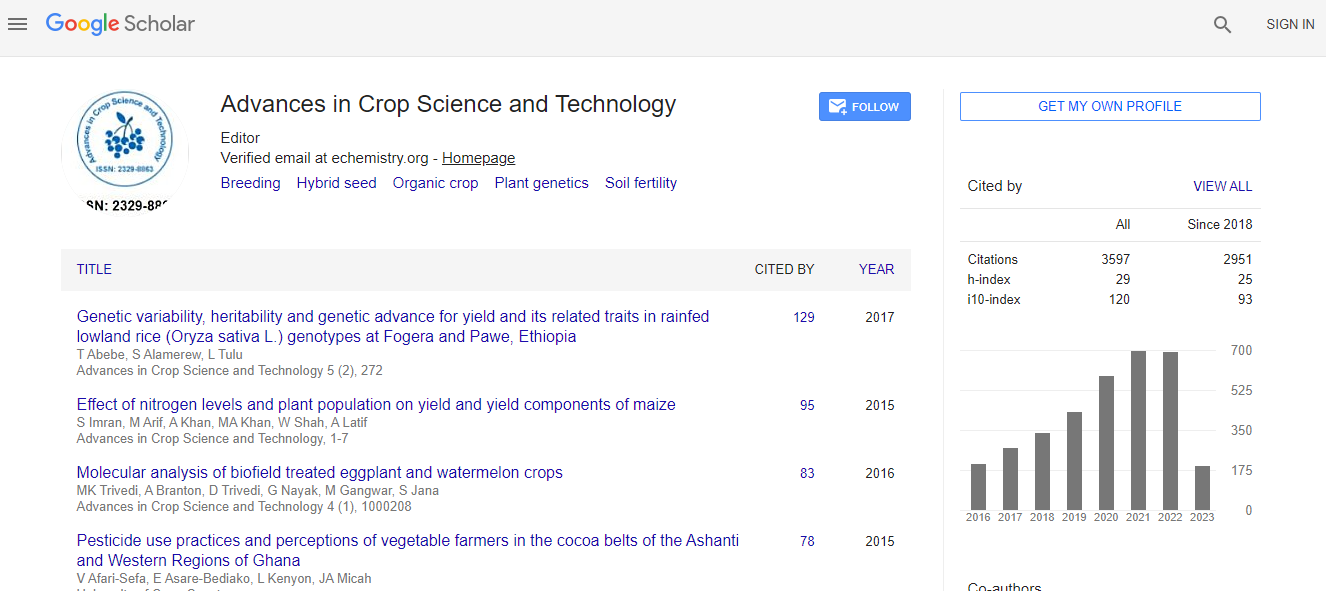Research Article
Identification of High-Temperature Tolerant and Agronomically Viable Tomato (S. lycopersicum) Genotypes from a Diverse Germplasm Collection
Muhammed Alsamir1,2, Nabil M Ahmad1*, Claudia Keitel3, Tariq Mahmood1 and Richard Trethowan1
1Plant Breeding Institute, University of Sydney, Cobbitty, NSW 2570, Australia
2The Date Palm Research Center, University of Basrah, Basrah, Iraq
3Centre for Carbon Water and Food, University of Sydney, Cobbitty, NSW 2570, Australia
- *Corresponding Author:
- Nabil M Ahmad
Plant Breeding Institute, University of Sydney
Cobbitty, NSW 2570, Australia
Tel: +61 2 9351 8829
E-mail: nabil.ahmad@sydney.edu.au
Received Date: July 26, 2017 Accepted Date: August 04, 2017 Published Date: August 11, 2017
Citation: Alsamir M, Ahmad NM, Keitel C, Mahmood T, Trethowan R (2017) Identification of High-Temperature Tolerant and Agronomically Viable Tomato (S. lycopersicum) Genotypes from a Diverse Germplasm Collection. Adv Crop Sci Tech 5: 299. doi: 10.4172/2329-8863.1000299
Copyright: © 2017 Alsamir M, et al. This is an open-access article distributed under the terms of the Creative Commons Attribution License, which permits unrestricted use, distribution, and reproduction in any medium, provided the original author and source are credited.
Abstract
The aim of most crop heat stress tolerance improvement programs is to increase productivity, not just survival, under high-temperature. Two cycles of experiments were conducted on forty four diverse tomato (S. lycopersicum) lines collected from UC Davis. These included one genotype each of the wild species S. pimpinellifolium (LA0373), S. Pennellii (LA0716) and S. chillense (LA1930). Experiments were conducted in both a growth-chamber and a polytunnel house. Three physiological parameters; stomatal conductance, electrolyte leakage (EL) and chlorophyll fluorescence were used to evaluate the first cycle materials in a growth chamber. Two-month old tomato plants were exposed to heat stress of 44°C for four hours and traits were assessed prior to and following heat shock treatment. Electrolyte leakage differentiated the materials best and was therefore used in subsequent evaluations.
In the second cycle of evaluation, the agronomic superiority of the more heat tolerant materials was assessed using an Agronomic Superiority Index (Ag Index) calculated using Euclidean distance for fruit set %, fruit yield, plant dry weight and EL. Plants were grown hydroponically in cocopeat bags in a tunnel house for two crop seasons. The temperature in the tunnel house was maintained using natural sunlight and controlled ventilation. The Ag Index successfully identified heat tolerant and agronomically superior genotypes and fruit yield and the Ag Index were strongly correlated (R2=0.96). Two lines, LA4284 and LA3847, were classified as superior for heat tolerance and agronomic performance. The EL response in the growth chamber and the tunnel house was significantly correlated (R2=0.30), thus validating the use of EL for screening. Histological studies on the selected lines confirmed that pollen development was significantly impaired by heat stress.

 Spanish
Spanish  Chinese
Chinese  Russian
Russian  German
German  French
French  Japanese
Japanese  Portuguese
Portuguese  Hindi
Hindi 
